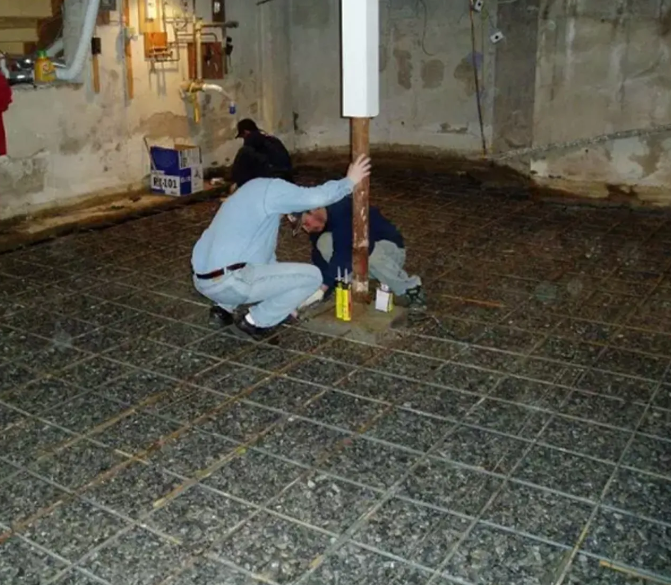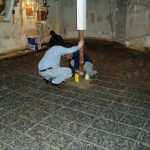Basement Waterproofing: Exploring Common Basement Repair Methods
A basement serves as the foundation of a home, both literally and figuratively. It provides essential support and utility, making it vital to maintain its structural integrity. Over time, various factors can lead to wear and tear, requiring homeowners to implement basement repair methods to ensure their property’s longevity and safety. In this article, we’ll delve into some common basement repair methods used to address a range of structural issues.
Interior Drainage Systems: Managing Moisture
Moisture management in the basement is crucial for maintaining a safe basement dry, and comfortable living environment. Interior drainage systems are an essential component of any effective basement moisture management strategy. They serve as a proactive solution to deal with water infiltration and prevent potential issues like mold growth, structural damage, and dampness. Let’s explore this method in more detail.
The Need for Interior Drainage Systems
Basements are inherently prone to moisture-related problems. This can be attributed to a variety of factors, including:
- Hydrostatic Pressure: The pressure exerted by groundwater surrounding the foundation can force water through cracks and joints in the basement walls and floor.
- Surface Water: Rainwater and surface runoff can seep into the basement, especially if the grading around the house is improper.
- High Water Tables: In some areas, the water table may be high, causing water to naturally rise and infiltrate the basement.
How Interior Drainage Systems Work
Interior drainage systems are designed to intercept, collect, and divert water away from the concrete foundation, preventing it from entering the basement. There are two common types of interior drainage systems:
- French Drains: A French drain consists of a perforated pipe installed beneath the basement floor along the perimeter. This pipe is enclosed in a bed of gravel to facilitate water flow. Any water that makes its way into the drain is collected and channeled to a sump pump for removal. French drains are particularly effective in managing hydrostatic pressure.
- Channel Drains: Channel drains are installed against the walls, just above the floor, and are used to collect water that might penetrate through wall cracks or gaps. Like French drains, they also direct collected water to a sump pump.
These systems work in conjunction with sump pumps, which automatically pump collected water out of the basement and away from the house and foundation.
Benefits of Interior Drainage Systems
- Effective Moisture Management: Interior drainage systems are highly effective in managing basement moisture. They prevent water from pooling on the basement floor and help maintain a dry and comfortable space.
- Preventing Structural Damage: By reducing moisture levels, these systems protect the structural integrity of the basement. Excessive moisture can lead to mold growth, rot, and deterioration of the foundation.
- Improved Air Quality: A dry basement has better indoor air quality, as it reduces the potential for mold and mildew growth, which can have adverse health effects.
- Long-Term Cost Savings: Investing in an interior drainage system is a cost-effective solution when compared to the expenses associated with repairing water damage and extensive basement renovations.
- Increased Home Value: A dry, well-maintained basement adds value to your home and enhances its resale potential.
Maintenance and Regular Inspections
To ensure the continued effectiveness of interior drainage systems, regular maintenance and inspections are essential. Homeowners should:
- Inspect the sump pump: Regularly check that the sump pump is operational and that the discharge pipe is free of obstructions.
- Clean drainage channels: Keep the channels and drains free from debris and blockages, ensuring they can effectively collect water.
- Examine for signs of damage: Look for signs of wear and tear on the drainage system and address any issues promptly.
Crack Injection: Restoring Integrity
Cracks in the walls and floors of your basement may seem like minor issues, but they can have significant consequences if left unaddressed. These cracks can occur due to a variety of reasons, including settling, shifting soil, and hydrostatic pressure. However, one of the most effective methods for repairing these openings and preventing water infiltration through basement walls is crack injection.
Understanding the Process
Crack injection is a versatile and widely used technique in the field of basement repair. It involves injecting specially formulated materials, such as epoxy or polyurethane resin, directly into the cracks in your basement walls or floors. As the injected material cures, it transforms into a robust, interior waterproofing seal. This seal not only closes the existing cracks but also strengthens the structure, restoring its integrity.
Benefits of Crack Injection
- Waterproofing: The primary purpose of crack injection is to create a waterproof barrier. This prevents moisture from entering your basement, safeguarding it against water damage, mold, and mildew. As moisture is one of the leading causes of basement issues, crack injection can effectively address this concern.
- Structural Stability: Cracks in your basement’s foundation can compromise its structural integrity. By sealing these cracks, you not only prevent water infiltration but also ensure the stability and longevity of your home’s foundation.
- Preventative Measure: Crack injection is not only a solution for existing cracks; it’s also a preventive measure. By addressing small cracks before they escalate into more extensive issues, you can save both time and money in the long run.
- Quick and Cost-Effective: In comparison to some other basement repair methods, crack injection is a relatively quick and cost-effective solution. It can be done with minimal disruption to your daily life and often at a fraction of the cost of more extensive structural repairs.
- Aesthetic Improvement: The materials used in crack injection are typically available in various colors. This means that after the process is complete, your basement’s walls or floors can appear as good as new.
Types of Injection Materials
Two primary materials used in crack injection are epoxy and polyurethane. Each has its advantages, making them suitable for different situations:
- Epoxy: Epoxy is a robust and durable material. It’s especially useful for structural repairs, as it bonds exceptionally well with concrete. Epoxy is an excellent choice when the crack’s primary concern is structural stability.
- Polyurethane: Polyurethane is a flexible material that can accommodate some degree of movement in the cracked area. This makes it suitable for non-structural cracks that may experience minor shifting. Polyurethane is also an excellent choice for waterproofing applications.
Maintenance and Regular Inspections
While crack injection effectively restores the integrity of your already waterproof basement walls, it’s essential to understand that regular maintenance and inspections are still necessary. These inspections can help identify new cracks, potential weaknesses, or any signs of wear and tear in the injected areas. Addressing issues promptly can prevent larger problems down the road.
In conclusion, crack injection is a versatile and effective basement repair method that not only addresses existing structural issues but also serves as a preventative measure against potential damage. It provides waterproofing, enhances structural stability, and can be a cost-effective solution for homeowners. By understanding this technique, homeowners can take proactive steps to ensure their basement’s structural integrity and long-term safety.
Exterior Waterproofing: Keeping Water at Bay
Water infiltration into the basement is a common concern for homeowners. When it comes to combating water intrusion at its source, exterior waterproofing your basement is one of the most effective methods. This approach creates a robust barrier between your home’s foundation and external moisture sources, ensuring that your basement stays dry and free from water-related issues.
The Importance of Exterior Waterproofing
Preventing water from entering the basement is crucial to maintaining its structural integrity and ensuring a safe living space. Exterior waterproofing addresses the root causes of basement water infiltration and offers numerous benefits:
- Protection Against Structural Damage: Moisture can weaken the foundation over time, leading to cracks, leaks, and even structural instability. Exterior waterproofing helps preserve the strength and longevity of your home’s foundation.
- Mold and Mildew Prevention: A dry basement is essential in preventing mold and mildew growth. Mold not only damages your property but also poses health risks to occupants.
- Enhanced Indoor Air Quality: By eliminating excess moisture, you improve the overall indoor air quality in your home. A dry basement means cleaner, healthier air throughout your living spaces.
- Increased Property Value: A well-maintained basement adds value to your home. Potential buyers often see a dry basement as a significant selling point.
- Long-Term Cost Savings: While exterior waterproofing involves an initial investment, it is a cost-effective solution when compared to the expenses associated with repairing water damage and conducting extensive basement renovations.
How Exterior Waterproofing Works
Exterior wall waterproofing is a comprehensive process that involves excavating the soil around the foundation to access the exterior walls. The key steps include:
- Excavation: The area around the foundation is excavated, exposing the exterior walls.
- Surface Preparation: The walls are cleaned and prepared for the waterproofing material.
- Application of Waterproof Membrane or Coating: A waterproof membrane or coating is applied to the exterior walls. This material forms a barrier that prevents water from penetrating the foundation.
- Drainage System Installation: In some cases, a drainage system like weeping tiles is installed to direct water away from the foundation.
- Backfilling: After the waterproofing material has been applied and cured, the excavated area is backfilled with soil.
- Grading and Landscaping: The surface is regraded to ensure proper drainage away from the foundation, and landscaping is restored.
Maintenance and Considerations
Exterior waterproofing is a long-term solution, but it is not maintenance-free. Homeowners should consider waterproofing products for the following:
- Regular Inspection: Periodically inspect the exterior walls for signs of damage or wear and tear. Address any issues promptly to maintain the integrity of the waterproofing.
- Grading: Ensure that the grading around your home slopes away from the foundation to prevent water from pooling near the walls.
- Vegetation: Be mindful of tree roots or large shrubs near the foundation, as they can potentially damage the waterproofing over time.
- Gutters and Downspouts: Keep gutters and downspouts clean and in good repair to prevent excess water from overflowing and saturating the ground near the foundation.
In conclusion, exterior waterproofing is a highly effective method for keeping water at bay and safeguarding your basement from potential water infiltration. It offers a range of benefits, from protecting your home’s structural integrity to improving indoor air quality. Regular inspections and maintenance ensure the continued effectiveness of the basement waterproofing system, helping homeowners enjoy a dry and comfortable living environment for years to come.
Creating a Safer, Drier, and More Beautiful Basement
In conclusion, maintaining a structurally sound, dry, and aesthetically pleasing basement is of paramount importance for homeowners. This article has explored a range of common basement repair and improvement methods that address structural issues, moisture management, and the overall functionality of your basement space. Whether you’re dealing with cracks in your basement walls, water buildup concerns, or a desire to enhance the appearance and comfort of your basement, there are effective solutions available.
From crack injection and installing interior drainage systems to sump pump installation, exterior waterproofing, window well installation, and concrete resurfacing, these methods offer diverse approaches to tackle various challenges that may arise over time. By understanding these techniques and the benefits they provide, homeowners can take proactive steps to ensure the longevity and safety of their basements, ultimately creating a more secure, comfortable, and visually appealing living environment.
Incorporating these basement repair and improvement methods into your maintenance and renovation plans can help you address common issues effectively. Regular inspections, maintenance, and professional assistance, when necessary, are crucial for preserving the integrity and aesthetics of your basement, ensuring it remains a valuable and functional part of your home for years to come. Whether you’re focused on structural stability, moisture management, or enhancing the overall look of your basement, these methods offer a roadmap to make a wet basement a safer, drier, and more enjoyable living space.
Contact the Professionals at A.M. Shield Waterproofing Corp. Today! (516) 294-8400




























